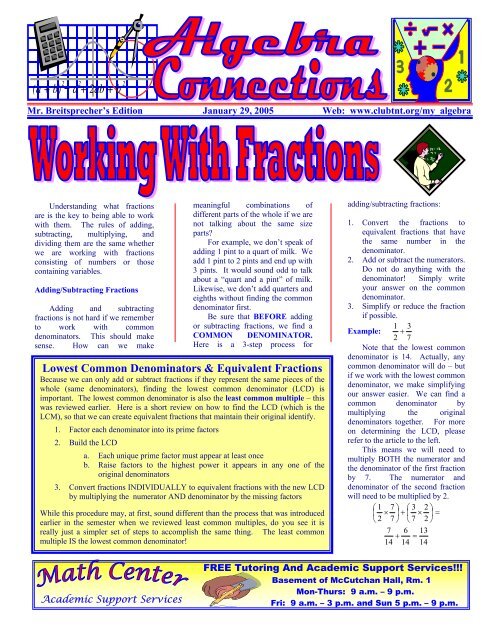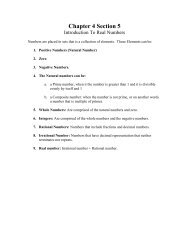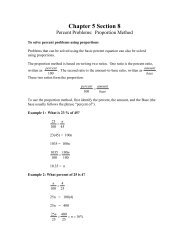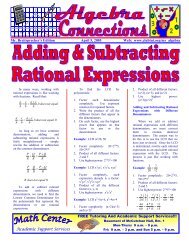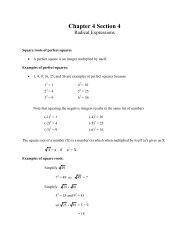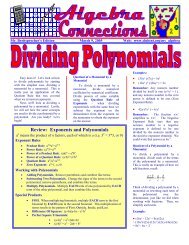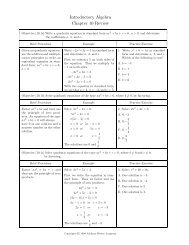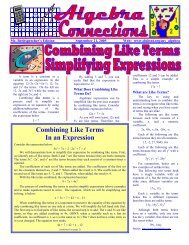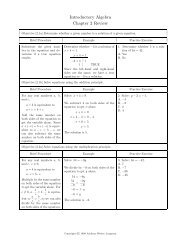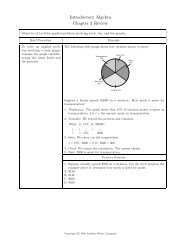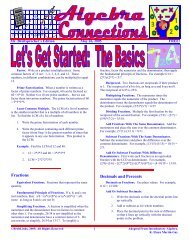Lowest Common Denominators & Equivalent ... - Madison VOICES
Lowest Common Denominators & Equivalent ... - Madison VOICES
Lowest Common Denominators & Equivalent ... - Madison VOICES
You also want an ePaper? Increase the reach of your titles
YUMPU automatically turns print PDFs into web optimized ePapers that Google loves.
Mr. Breitsprecher’s Edition January 29, 2005 Web: www.clubtnt.org/my_algebra<br />
Understanding what fractions<br />
are is the key to being able to work<br />
with them. The rules of adding,<br />
subtracting, multiplying, and<br />
dividing them are the same whether<br />
we are working with fractions<br />
consisting of numbers or those<br />
containing variables.<br />
Adding/Subtracting Fractions<br />
Adding and subtracting<br />
fractions is not hard if we remember<br />
to work with common<br />
denominators. This should make<br />
sense. How can we make<br />
meaningful combinations of<br />
different parts of the whole if we are<br />
not talking about the same size<br />
parts?<br />
For example, we don’t speak of<br />
adding 1 pint to a quart of milk. We<br />
add 1 pint to 2 pints and end up with<br />
3 pints. It would sound odd to talk<br />
about a “quart and a pint” of milk.<br />
Likewise, we don’t add quarters and<br />
eighths without finding the common<br />
denominator first.<br />
Be sure that BEFORE adding<br />
or subtracting fractions, we find a<br />
COMMON DENOMINATOR.<br />
Here is a 3-step process for<br />
<strong>Lowest</strong> <strong>Common</strong> <strong>Denominators</strong> & <strong>Equivalent</strong> Fractions<br />
Because we can only add or subtract fractions if they represent the same pieces of the<br />
whole (same denominators), finding the lowest common denominator (LCD) is<br />
important. The lowest common denominator is also the least common multiple – this<br />
was reviewed earlier. Here is a short review on how to find the LCD (which is the<br />
LCM), so that we can create equivalent fractions that maintain their original identify.<br />
1. Factor each denominator into its prime factors<br />
2. Build the LCD<br />
a. Each unique prime factor must appear at least once<br />
b. Raise factors to the highest power it appears in any one of the<br />
original denominators<br />
3. Convert fractions INDIVIDUALLY to equivalent fractions with the new LCD<br />
by multiplying the numerator AND denominator by the missing factors<br />
While this procedure may, at first, sound different than the process that was introduced<br />
earlier in the semester when we reviewed least common multiples, do you see it is<br />
really just a simpler set of steps to accomplish the same thing. The least common<br />
multiple IS the lowest common denominator!<br />
adding/subtracting fractions:<br />
1. Convert the fractions to<br />
equivalent fractions that have<br />
the same number in the<br />
denominator.<br />
2. Add or subtract the numerators.<br />
Do not do anything with the<br />
denominator! Simply write<br />
your answer on the common<br />
denominator.<br />
3. Simplify or reduce the fraction<br />
if possible.<br />
1 3<br />
Example: +<br />
2 7<br />
Note that the lowest common<br />
denominator is 14. Actually, any<br />
common denominator will do – but<br />
if we work with the lowest common<br />
denominator, we make simplifying<br />
our answer easier. We can find a<br />
common denominator by<br />
multiplying the original<br />
denominators together. For more<br />
on determining the LCD, please<br />
refer to the article to the left.<br />
This means we will need to<br />
multiply BOTH the numerator and<br />
the denominator of the first fraction<br />
by 7. The numerator and<br />
denominator of the second fraction<br />
will need to be multiplied by 2.<br />
⎛ 1 7 ⎞ ⎛ 3 2 ⎞<br />
⎜ × ⎟ + ⎜ × ⎟ =<br />
⎝ 2 7 ⎠ ⎝ 7 2 ⎠<br />
7 6 13<br />
+ =<br />
14 14 14<br />
Academic Support Services<br />
FREE Tutoring And Academic Support Services!!!<br />
Basement of McCutchan Hall, Rm. 1<br />
Mon-Thurs: 9 a.m. – 9 p.m.<br />
Fri: 9 a.m. – 3 p.m. and Sun 5 p.m. – 9 p.m.
Mr. Breitsprecher’s Edition January 29, 2005 Algebra Connections, Page 2<br />
⎛ 8 1 ⎞<br />
Example: ⎜ − ⎟<br />
⎝15<br />
2 ⎠<br />
The lowest common denominator<br />
here is 30 – it happens to be the<br />
product of the 2 different<br />
denominators we started out with.<br />
This will always work, but when we<br />
start out with larger numbers in the<br />
denominators, it becomes more<br />
cumbersome to work with.<br />
We will need to multiply BOTH<br />
the numerator and the denominator of<br />
the first fraction by 2. The numerator<br />
and denominator of the second<br />
fraction will need to be multiplied by<br />
15.<br />
⎛ 8 2 ⎞ ⎛ 1 15 ⎞<br />
⎜ × ⎟ − ⎜ × ⎟ =<br />
⎝15<br />
2 ⎠ ⎝ 2 15 ⎠<br />
16<br />
30<br />
15<br />
− =<br />
30<br />
1<br />
30<br />
Note that when adding or<br />
subtracting mixed fractions, we can<br />
add/subtract each part by itself (whole<br />
number and fraction) and write the<br />
answer together. The key is to be sure<br />
the fractional part has a common<br />
denominator.<br />
Example:<br />
2<br />
1 +<br />
3<br />
1<br />
2<br />
6<br />
Adding the whole number part of<br />
these mixed fractions is<br />
straightforward (1+2=3). To add the<br />
fraction part, we need to find a<br />
common denominator – the lowest<br />
common denominator (LCD) is 12.<br />
We will need to multiply BOTH<br />
the numerator and the denominator of<br />
the first fraction by 4. The numerator<br />
and denominator of the second<br />
fraction will need to be multiplied by<br />
2. Adding the fraction part (using the<br />
common denominator):<br />
⎛ 2 4 ⎞ ⎛ 1 2 ⎞<br />
⎜ × ⎟ + ⎜ × ⎟ =<br />
⎝ 3 4 ⎠ ⎝ 6 2 ⎠<br />
8 2 10 5<br />
+ = =<br />
12 12 12 6<br />
Now we can combine our 2 parts<br />
(whole and fraction) to get:<br />
5<br />
3<br />
6<br />
Multiplying Fractions<br />
In many ways, multiplying<br />
fractions is the easiest operation of the<br />
four. There is no need to have a<br />
common denominator. Be careful<br />
with mixed fractions, however.<br />
Before multiplying them, re-write<br />
them as an improper fraction. You<br />
can always express your final answer<br />
back to a mixed fraction, if need be.<br />
Here is a 3-step process for<br />
multiplying fractions:<br />
1. Change all mixed fractions to<br />
improper fractions<br />
2. Multiply the numerators together<br />
and multiply the denominators<br />
together. Each results in the<br />
numerator/denominator of your<br />
answer.<br />
3. Simplify or reduce the fraction if<br />
possible.<br />
Example:<br />
3<br />
×<br />
8<br />
2<br />
7<br />
=<br />
Dividing Fractions<br />
Pre-Owned Vehicles in First-Crash Condition!<br />
6<br />
56<br />
or<br />
3<br />
28<br />
If one understands how to<br />
multiply fractions, dividing them is<br />
not hard. Recall that we can define<br />
division in terms of multiplication –<br />
instead of dividing by a number; we<br />
can multiply by the reciprocal. This is<br />
true in EVERY case – but it is<br />
essential when dividing fractions.<br />
Here is a 3-step process for dividing<br />
fractions:<br />
1. Change all mixed numbers to<br />
improper fractions.<br />
2. Flip the second fraction,<br />
placing the bottom number on top and<br />
the top number on the bottom.<br />
3. Continue as with the<br />
multiplication of fractions.<br />
5 2<br />
Example: ÷<br />
12 9<br />
5 9 45 15<br />
= × = or<br />
12 2 24 8<br />
When dividing fractions, note that we<br />
have really just taken advantage of our<br />
definition for division. Thinking of<br />
Why go anywhere else and get<br />
taken advantage of?<br />
COME HERE FIRST!<br />
division in terms of multiplication by<br />
the reciprocal and thinking of<br />
subtraction in terms of addition of the<br />
opposite (change sign) can be useful.<br />
Note that addition and<br />
multiplication share a special feature:<br />
order does not matter (commutative<br />
and associative properties of<br />
addition/multiplication). This means<br />
that when we are adding or<br />
multiplying fractions, we can work<br />
with more than 2 at a time.<br />
Decimals = Fractions<br />
We should close our review of<br />
fractions by pointing out that decimals<br />
are really just fractions where he<br />
indicated division has been performed.<br />
They are really the same as fractions<br />
with denominators of 10, 100, 1,000,<br />
and so forth.<br />
The decimal point really indicates<br />
that we are dealing with a “part-of-awhole”<br />
or a fraction. Because the<br />
denominators of these fractions are<br />
always a multiple of ten, it is easier to<br />
indicate this with a decimal point.<br />
Example:<br />
12 .31 = 12<br />
31<br />
100<br />
More Fraction Resources<br />
Fractions, Decimals, Percentages:<br />
Explanations<br />
http://descartes.cnice.mecd.es/ingles/3<br />
rd_year_secondary_educ/Fract_dec_pt<br />
ges/Fracciones_1.htm<br />
Simplifying Fractions<br />
http://www.helpwithfractions.com/sim<br />
plifying-fractions.html<br />
Fraction Links<br />
http://www.mathleague.com/help/fract<br />
ions/fractions.htm<br />
Reducing Fractions & LCD<br />
http://www.sparknotes.com/math/preal<br />
gebra/fractions/section2.rhtml<br />
Fractions Fast Facts<br />
http://www.mccc.edu/~kelld/fraff.ht<br />
m<br />
PowerPoint Presentation: Finding<br />
the <strong>Lowest</strong> <strong>Common</strong> Denominator<br />
http://www.ceres.k12.ca.us/iweb/lesso<br />
ns/Monica's%20Math/Fractions%20XI<br />
I.ppt


